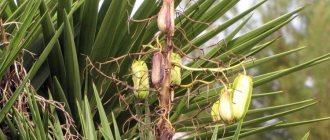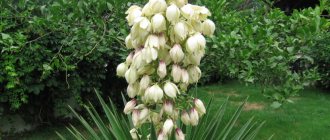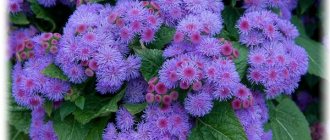Today, the garden palm or yucca grows among many owners of garden plantings, and this phenomenon will not surprise anyone.
Many gardeners can rightfully be proud of the amazingly beautiful plant that resembles a palm tree and grows in their plots. But some are afraid to grow such beauty, mistakenly believing that the plant is too demanding in terms of growing conditions and care. In fact, propagation and care for this plant do not require much effort or expense.
Description and origin of the garden palm
Description of Yucca
The homeland of evergreen yucca is America. This plant belongs to the Asparagus family; in its appearance it resembles the Mediterranean agave, but unlike the latter, its leaves form a dense spiral rosette.
Domestic representatives of this family have a well-developed stem, while specimens growing in open ground have almost none; the rosettes are located tightly pressed to the ground. The peduncle is represented by a large panicle, the flowers of which are lowered down like bells. It protrudes from the central part of the rosettes, reaching a height of 1.5 to 3 meters. The exotic palm tree reproduces by root suckers.
Agave
In America and Mexico, industrial cultivation of agave, a relative of yuca, is practiced on huge plantations. The world famous tequila is produced from its stem.
The exotic appearance of the plant would seem to imply comfortable natural growing conditions, but the tropics and subtropics of America, the natural habitat for yucca, do not have such characteristics at all. The plant is adapted to prolonged drought and sudden changes in temperature. Such amazing endurance allowed the plant to spread from the southern regions to the middle continents.
Yuca appeared in Russia over a century ago. But if in the last century only the parks of famous palaces could boast of this amazing plant, today squares and city parks are replete with it, as well as many private plots.
Useful tips
Sometimes yucca planted in open ground refuses to bloom. The plant develops well, produces annual growth, but does not bloom. Why doesn't yucca bloom? What agrotechnical measures need to be carried out to stimulate flowering?
To make an adult yucca bloom, you should not cut off the lower leaves, even if they have lost their decorative effect.
Some plants, due to their individual characteristics, bloom at a later date than other specimens planted in the garden. Incorporating double superphosphate into the soil in the fall will help stimulate the formation of yucca buds. The long-acting fertilizer dissolves slowly, and the plant roots absorb the nutritional composition. By spring, plants accumulate a sufficient amount of nutrients that stimulate the appearance of flower buds.
What types and varieties are there?
filamentous yucca
- Gray Yucca (Yucca Glauca) or the Lord's Candle, as it is also popularly called. The length of the leaves reaches 90 cm, the trunk is short. The leaves have a grayish-green tint. Along the perimeter the leaf blade is lighter. Small inflorescences are collected from greenish-white or yellowish flowers. The peduncle stretches up to three meters in length. This species has no substrate requirements. It can easily grow even in sand, tolerates dry periods and low temperatures well, but excessive soil moisture is detrimental to it.
- Yucca filamentosa (Yucca Filamentosa).
A bush representative, the castings of which are slightly smaller and reach a length of up to 70 cm, and the width ranges from 3 to 10 cm. The edges of the leaf plates are bordered by slightly protruding threads, and the top of the plates is slightly bent. The length of the peduncle is 2.5 m, represented by beige-white drooping flowers. Representative yucca filamentous planting and care. Like other species, it is a very unpretentious frost-resistant plant that can withstand temperatures down to -20C. Giant Yucca - Yucca elephantipes or “tree of happiness.” It got its name due to the shape of the trunk, which is strong and straight, slightly thicker at the bottom. This variety is often planted in apartments and offices. It can grow up to 9 meters, but by trimming the top, growth in height can be stopped. Subsequently, it sprouts several side shoots and becomes lush.
- Yucca aloelia can grow about eight meters. It has beautiful dark green leaves and cream flowers with purple splashes.
- Yucca Whippla is native to Mexico and Arizona. It is distinguished by white-cream tall flowers with a delicate aroma, as if floating above long dark green leaves.
- Yucca coracata can grow up to only three meters, so it can be considered a miniature variety compared to others.
Yellow flowers - Yucca southern or filamentous . A tall species capable of reaching 10 meters. Hanging threads are visible from each leaf, hence the second name.
- Yucca Trekulya. Grows in Mexico and southern America. It has meter-long leathery leaves of dark green color. And meter-long inflorescences with a delicate aroma.
- Yucca glorious or Spanish dagger can be found in the southern regions of America. It grows just above two meters. It has giant panicle inflorescences that soar 2-3 meters into the air.
- Yucca Schotta or large-fruited. In nature, it can often be found in the southern parts of Arizona. It blooms with a loose cream panicle.
- Yucca radiata. Another giant representative of its genus, able to reach 8-9 meters. Numerous half-meter sheets have a lightened part at the very tip, because of this it seems to glow.
- Yucca giant or short-leaved. Can be found in California and Arizona. Trunk diameter 0.5 m, height 9-10 m. The leaves are short, only 20-40 cm, but multiple. Peduncles have a creamy-yellowish tint.
Among the F. variegata filamentose hybrids, the following interesting varieties are distinguished:
- Bright Edge - bright bluish-green foliage, surrounded by a yellowish-crimson ribbon;
- Color Guard - wide leaf plates of yellow color, edged with a green stripe;
- Gold Heart – yellow foliage, green edge running along the leaf blade with blurred boundaries;
- Ivory Tower – green foliage, whitish border.
Garden palm care and planting in the garden
Despite its unpretentiousness and hardiness, yucca feels especially comfortable in elevated places with good lighting. Representatives growing in dark places are characterized by thin, loose rosettes and pale leaf blades.
When and how to plant a flower of happiness
Spring is the most favorable time for planting, but temperatures should not fall below +10C. The dense structure of the leaves can lead to numerous cuts and hand injuries, so gloves must be used when replanting the plant. The plant transplant itself is carried out in the spring, but preparatory work must be done in the fall: dig up the ground and form a hole for the spring transplantation of the plant.
What kind of soil is needed
Yucca can grow in almost any soil, but you need to remember that air should be supplied to the roots in large quantities, and the soil should not be overly moist, preferably without close proximity to groundwater, in order to avoid rotting.
But most of all, garden yucca prefers calcareous, sandy, clay-stony soils and black soil.
If the soil in which the plant grows is poor in nutrients, it is saturated with humus.
Before transplanting, the hole is filled with coarse gravel or sand with the addition of two handfuls of ash. After planting, the soil should be pressed (compacted) and watered.
- The size of the planting hole depends on the size of the plant itself.
- Adult plants will need a recess up to 50 cm deep and an area of up to 1 m in circumference.
- Young specimens will require less space, but it is necessary to take into account the area required for the growth of young animals.
To make it easier for a purchased plant to outdoor conditions, it is recommended to harden the plant for 11-14 days, regularly taking the plant outside, gradually increasing the time it spends outdoors. Only after such preparation can the bush be safely transplanted to a personal plot.
Watering and fertilizing
In the processes of watering and fertilizing, the main thing is to know when to stop.
Excessive watering threatens rotting of the roots, and lack of moisture will certainly affect the condition of the leaves. They will begin to curl into tubes. Proper watering will help straighten the leaf blades. There is no need to water the plant often and only when the top layer of soil has dried out. Spraying the leaves is useful, which is carried out in the morning or evening hours, when there is no longer scorching sunlight. When does yucca bloom? This exotic plant blooms when it has been growing for 3-4 years. To begin this process, at the beginning of summer, the plant trunk is surrounded with superphosphate, which, dissolving in water, penetrates to the roots of the plant, starting the process of the formation of numerous buds.
Feeding the plant should be completed 30-40 days before the onset of autumn cold weather. During this period, the plants will have time to prepare for the winter season and severe frosts.
Incorrect landing
Very often the reason for the lack of flowers is a lack of light. But an incorrect landing can cause just as much trouble. The root collar of the plant is very vulnerable to pests and pathogenic organisms. And sometimes the reason why cinquefoil does not bloom well is that the root collar is below ground level. This is where all the fungal and other diseases of the plant come from, so you will have to tinker with the release of this part.
Flowering cinquefoil
Sometimes cinquefoil blooms poorly because too little space was left between the bushes, and as a result the plants simply get in the way of each other. Therefore, when planning their planting, you need to mark the area so that the distance between the bushes is at least 40 cm, or even more.
The plant is planted in spring or autumn. Planting holes are dug taking into account the fact that the root system of the cinquefoil does not lie deep, but is located almost at the surface.
Cinquefoil variety Goldfinger
The reason the plant failed to flower may be that the planting hole was not well drained and as a result there is stagnation of water at that level. From the very beginning, you need to lay a layer of crushed stone or broken brick at the bottom of the hole, cover it with a layer of earth and humus, and only after that plant the plant.
Important! It is recommended to add a small amount of ash and mineral fertilizers to the soil mixture. Then, provided there are no other violations, lush flowering of the cinquefoil is almost guaranteed. . Planting of the plant ends with abundant watering, and the soil around the bush is then mulched
In the future, you need to ensure that the soil around the plant does not dry out. If proper watering cannot be established, then beautiful yellow flowers on the cinquefoil may not appear.
Planting of the plant is completed with abundant watering, and the soil around the bush is then mulched. In the future, you need to ensure that the soil around the plant does not dry out. If proper watering cannot be established, then beautiful yellow flowers may not appear on the cinquefoil.
When to replant garden yucca
If the plant grows in conditions that are comfortable for it and with the same good care, then it can live perfectly in one place, without requiring replanting, for up to 20 years. And replanting a plant may only be necessary when the bush has grown excessively. This is especially painless for the plant if the age of the specimen has not yet reached three years.
Transplanting filamentous yucca video:
But even an adult, heavily grown plant needs a transplant. Plants often cannot tolerate transplantation.
Experts give some advice when replanting this plant, because you need to take into account some planting features.
- Transplantation period is spring or late summer.
- When replanting, remember that the roots of the plant can be located at a depth of up to 80 cm, so you need to dig it out carefully, without damaging the root system.
- All shoots must be separated from the adult specimen and planted separately.
- The conditions of the place intended for transplantation should resemble the previous one, have good lighting, and no drafts.
- It is better to carry out the first feeding after transplantation no earlier than two weeks.
Reproduction and transplantation
Garden yucca can remain decorative for twenty years, but the plant needs timely replanting:
- if the false palm has grown and numerous shoots have appeared, but they need to be separated and replanted, and the garden crop needs to be replanted;
- the root system can be buried 60-70 cm, so to reduce the risk of damage to the roots you need to dig deep enough;
- replanting garden yucca can be done not only in spring, but also in the last ten days of summer;
- Flowering of the false palm after transplantation occurs in about a year.
Garden yucca reproduces by seeds and vegetatively. In our country, propagation is used by bush division and stem cuttings.
Yucca propagation: how to do it right
For breeding there are the following methods.
- Root division
- Cuttings
- Propagation from seeds
- stem
Yucca propagation at home is simple - dividing the plant .
During the replanting process, the rosettes can be easily separated, not forgetting to dry them and sprinkle the cut areas with cinnamon powder or charcoal. Otherwise, infection or pests may enter them. If the transplant is carried out in the spring, then the root of the plant can be divided into cuttings, the length of which does not exceed 10 cm. Such cuttings are placed in a greenhouse, after first cutting off the top of the stem and treating it with charcoal. With this method, sprouts emerge from dormant buds.
Garden yucca in open ground sets seeds, which are collected at the end of summer. They are sown in a mixture of soil, which is represented by turf, leaf soil and coarse sand in equal proportions. Plants grown in this way begin to bloom only three years after planting.
Yucca can also be propagated by stems. In this case, the cut section of the stem is dried and planted horizontally in river sand. The substrate around the stem must be constantly kept moist. When sprouts appear, the stem is cut into fragments, each of which should contain a sprout, and planted in the substrate.
You choose the most suitable way for yourself to plant yucca.
How to trim yucca at home
Pruning the plant rejuvenates it and helps produce strong young seedlings. This method is also used for frostbite of flowers and their rotting. In the spring, when the plant is no longer under winter cover, the stem is pruned. At the same time, further growth of the plant stops, and dormant buds begin to wake up, which will give rise to new rosettes with leaves.
- Before pruning, the plant must be watered.
- It is necessary to cut the stem below the growing leaves by 6-9 cm.
- After drying, the cut areas are sprinkled with charcoal.
Yucca after winter, care for yucca in spring
With the onset of spring, after the winter shelter has been removed from the yucca, it must be untied and inspected for damage and fungal diseases. Then prune the dry leaves to allow the bush to open up. In early spring, it also needs to be fed with mineral or organic fertilizers, providing the plant with the opportunity to actively develop.
Flowering and why yucca does not bloom
Yuccas bloom with gorgeous flowers of various shades and color combinations; their appearance is similar to delicate bells placed on a giant rod.
The arrangement of numerous bright bell flowers on one leg gives the plant decorative properties. But there may be several such peduncles. And you can’t even imagine what amazing beauty it is.
The snow-white color of numerous bells is clearly visible even at dusk and from the far corners of the garden. The delicate and not cloying aroma attracts the attention of both people and many insects.
What year does yucca bloom?
- Sometimes it can bloom after transplantation only in the 4-5th year.
- The reason for this may be severe winter frosts, which can damage the above-ground part of the plant.
- Lack of lighting can also slow down the flowering process.
If the growing conditions and care of the plant were good, this will certainly be reflected in its appearance; flowering will be abundant and will last up to 2-3 weeks, which necessarily fall in the first two summer months. Blooming yucca is an unforgettable sight.
What factors influence the flowering of yucca
There can be many reasons why yucca does not bloom, all of them are directly related to improper care. The main factors influencing the inability of yucca to bloom:
- waterlogging of the soil;
- diseases;
- pest damage;
- incorrectly selected growing area;
- violations when planting seedlings in the ground;
- hypothermia of the root system;
- lack of nutrients in the soil, error in dosage or incorrectly selected fertilizers;
- mechanical damage to the underground and above-ground parts of the bush during loosening or pruning;
- lack of preparation of the bush for the winter;
- annual transplants or their complete absence;
- lack of lighting.
Why the orchid does not bloom - possible reasons
If all these reasons have nothing to do with the bush, and the appearance of the yucca is healthy, perhaps the bush is still young and is not physiologically capable of blooming. The setting of buds can only be done 4-6 years from the date of planting.
Note! In rare cases, a bush may bloom only after 7 years.
Dry air causes lack of flowering
Air humidity
Air humidity indicators are especially influential if yucca is grown indoors. With the beginning of the heating seasons, the air suddenly becomes dry, causing the plant’s condition to deteriorate: normal development stops, and the leaf blades begin to dry out. The delicate flowers of the bush are especially affected, as they begin to crumble, and new buds cannot be formed due to the weakened state of the plant.
Temperature
Low temperatures lead to supercooling of the soil, and the root system begins to die. During the active growth period, the temperature should not drop below 6 °C. The optimal growing temperature is considered to be 18-15 °C.
Important! Under no circumstances should sudden changes in temperature be allowed; this usually happens due to drafts.
Watering
Too much improper watering provokes rotting of the stems. They begin to die off and the plant cannot develop normally. Watering with low-quality water can aggravate the situation. It is not recommended to use cold tap water, otherwise the bush will not bloom.
Diseases and pests greatly affect the possibility of buds setting
How to cover for the winter
Is it necessary to dig up yucca before frost?
It is enough to insulate the plant before the cold season sets in. Plants tolerate short-term cold in spring and autumn quite easily. It is important that the fallen snow melts quickly. Frost-resistant specimens perceive such temporary inconveniences especially easily. But real long frosts during a snowless winter are certain death for garden yucca.
The yuca foliage is wrapped with twine to gather it together and the plant is covered with a box, on top of which spruce branches or fallen leaves are laid. This composition is secured by a covering material wrapped with tape. In such a shelter, the yucca will easily overwinter without fear of any frost, especially when a large layer of fluffy snow falls on top.
In the spring, when the temperature becomes stable, it is time to free the plant from its winter shelter. Do not delay this for too long, otherwise it may lead to the appearance of mold.
Preparing for winter and wintering
Particular attention is paid to preparing yucca for winter. The amount of work depends on whether your region needs to cover it for the winter or not.
Wintering without shelter
In the south of Russia and Ukraine, where frosts, even if they drop below 20 ° C, then only for a short time, yucca overwinters without shelter. You don’t have to do anything at all, but in this case the bushes will look unkempt after wintering, some of the leaves will break under the weight of snow and gusts of wind, and some will freeze. Moreover, not only the outer leaves will suffer, but also the middle of the bush. What should I do to avoid this?
Before the onset of persistent cold weather, the bushes need to be tied, collecting the leaves of each rosette into cones. This will prevent them from being damaged by snow. In addition, the more delicate core with the apical bud will be protected by several layers of dense leathery leaves. To protect the rhizome from freezing, the soil around is mulched with humus, peat chips, and leaf litter.
In most cases, such preparation is sufficient for successful wintering of filamentous yucca in the Krasnodar region, Kuban, Rostov region, and Crimea.
Yucca flower, how to care if problems arise
Yucca, like all plants, can be attacked by pests or diseases.
The most common are slugs, whiteflies, scale insects, and aphids.
The latter easily gets on the flowers, which quickly dry out and fall off. Wood ash in combination with a soap solution will help in the fight not only against aphids, but also against other insects.
You need to take 0.250 wood ash, pour water (10 l) and bring to a boil, adding 0.50 grams of ordinary laundry soap (grated). When the resulting solution has cooled completely, immediately treat the affected leaves.
Possible problems
- Dry air and cold drafts contribute to the formation of untidy brown leaf tips that spoil the appearance.
- Brown spots throughout the leaf may indicate fungal diseases caused by possible overwatering.
- Bright sun rays can affect the appearance of light, dry spots.
Diseases and pests as reasons for the lack of flowers
Yucca often gets sick with fungal diseases:
- Cercospora blight is an infectious fungus that appears due to stagnation of water in the soil;
- brown spotting affects the lower parts of the bush, expressed in the form of brown spots;
- marginal leaf necrosis affects the leaf blades with grayish-brown spots;
- Fusarium is a dangerous fungal disease that is practically untreatable.
Why adenium does not bloom - reasons
Yucca most often suffers from spider mites, which are located on its leaf blades. Insects feed on the succulent, fleshy leaves and suck the juice from the stems. Spider mites can be recognized with the naked eye, despite the fact that the insects have a very small body size. Ticks cover the surface of the above-ground part of the bush with a thin web.
Note! To destroy pests, insecticides are usually used, but acaricides are used against spider mites. In addition, it is useful to carry out regular preventive measures against the appearance of pests - spraying with special chemicals.
In landscape design
If yucca grows in the garden, then the surrounding landscape immediately takes on a Mediterranean hue.
It will look great even in the driest areas and territories. It is the appearance, reminiscent of a palm tree, that gives the garden plot a special southern atmosphere, especially if other southern representatives, such as garden hibiscus, are located nearby. Even if yucca grows as a single plant, it is able to captivate with its appearance during the flowering period and at this moment become the brightest and most colorful spot on the garden plot.
Some types are used in the design of verandas, staircases and other architectural structures. Such options do not require winter shelters or special rooms for the winter season.











